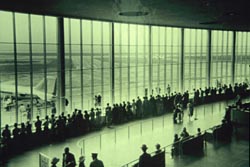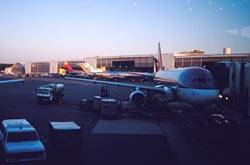
The Washington National Airport Terminal and South Hangar Line, products of New Deal initiatives, were milestones in American aviation technology. Washington, D.C.'s first airport, Washington-Hoover, was deemed inadequate in 1927. In July of that year, a joint airport committee voted to approve Gravelly Point as the site for a new airport. After 11 years of debate, President Roosevelt authorized federal sponsorship of a government-owned airport at Gravelly Point. The Terminal was opened for operation on June 16, 1941, blending three distinct styles--Art Deco/Steamlined Moderne, Colonial Revival and Stripped Classical. Its architecture is also a striking example of architectural resolution; its form--a combination of streamlined horizontal massing overlayed with a dominant vertical portico--mirrors the architectural polemic of the pre-World War II era, the debate on American architecture's future as Modernist or Neoclassical. The stepped massing, banded fenestration, sidewalk canopies and stylized ornament speak of the Art Deco/Moderne movement. The building's portico-and-wing composition draws upon the regional Colonial architecture of 18th-century Virginia. However, the execution of the portico as a "stripped" expression of Classicism promotes the ideals of World War II-era government buildings.
Within six months of its opening, airport operations were dominated by military uses. With the onset of World War II, civilian aircraft were appropriated by the military and civilian flights fell by 50 percent. By 1946, newspaper accounts described Washington National Airport as the third busiest postwar airport. The airport also served as the home airport for the airplanes of Presidents Roosevelt, Truman and Eisenhower. The footprint, massing, floor plan and diamond-shaped control tower design of the Terminal building, as well as the runway configuration, runway lengths and advanced lighting and instrument landing systems were innovations that influenced airport design throughout the country. Its functional clarity and provisions for spectatorship were particularly influential in later terminal designs.

The South Hangar Line, constructed between 1941 and 1948, consisted of seven hangars designed to accommodate advances in airplane technology. The South Hangar Line employed innovations such as a new door design, unit heaters with blowers used to maintain the hangar's standard 60-degree temperature and a sprinkler system. For many years the Washington National Airport Terminal and South Hangar Line, the nation's first federally constructed commercial airport, served as the Civil Aeronautics Authority's model airport. Historic Terminal A is undergoing renovation to restore the terminal to its original appearance.
Visit the National Park Service Travel American Aviation to learn more about Aviation related Historic Sites.
![]()
Last updated: August 29, 2017
